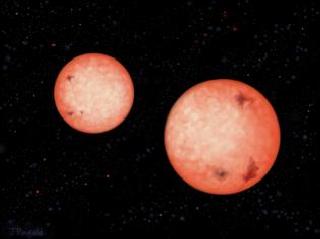
This artist's impression shows the tightest of the new record breaking binary systems. Two active M4 type red dwarfs orbit each other every 2.5 hours, as they continue to spiral inwards. Image Credit: J. Pinfield, for the RoPACS network.
LONDON (PTI): Astronomers claim to have discovered four pairs of stars that orbit each other in less than four hours, a finding which they say debunks the theory that such close-in binary stars could not exist.
About half of the stars in our galaxy, unlike the Sun, are part of a binary system in which two stars orbit each other. Most likely, the stars in these systems were formed close together and have been in orbit around each other from birth onwards.
But, it was always thought that if binary stars form too close to each other, they would quickly merge into one single, bigger star.
This is for the first time, scientists using the Hawaii- based UK Infrared Telescope (UKIRT) investigated binaries of red dwarfs, stars up to 10 times smaller and a thousand times less luminous than the Sun.
Although they form the most common type of star in the Milky Way, red dwarfs do not show up in normal surveys because of their dimness in visible light.
For the last five years, UKIRT has been monitoring the brightness of hundreds of thousands of stars, including thousands of red dwarfs, in near-infrared light, using its state-of-the-art Wide-Field Camera (WFC).
"To our complete surprise, we found several red dwarf binaries with orbital periods significantly shorter than the 5 hour cut-off found for Sun-like stars, something previously thought to be impossible," said lead study author Bas Nefs from Leiden Observatory in the Netherlands.
"It means that we have to rethink how these close-in binaries form and evolve," he said in a paper published in the journal Monthly Notices of the Royal Astronomical Society.
Since stars shrink in size early in their lifetime, the fact that these very tight binaries exist means that their orbits must also have shrunk as well since their birth, otherwise the stars would have been in contact early on and have merged. However, it is not at all clear how these orbits could have shrunk by so much.
One possible answer to this riddle is that cool stars in binary systems are much more active and violent than thought earlier, the researchers said.
It's possible that the magnetic field lines radiating out from the cool star companions get twisted and deformed as they spiral in towards each other, generating the extra activity through stellar wind, explosive flaring and star spots.
Powerful magnetic activity could apply the brakes to these spinning stars, slowing them down so that they move closer together, they added.
 Previous Article
Previous Article Next Article
Next Article












The Indian Air Force, in its flight trials evaluation report submitted before the Defence Ministry l..
view articleAn insight into the Medium Multi-Role Combat Aircraft competition...
view articleSky enthusiasts can now spot the International Space Station (ISS) commanded by Indian-American astr..
view article